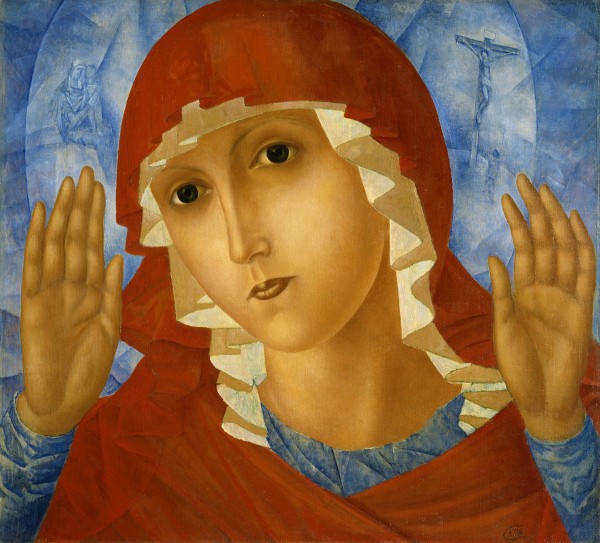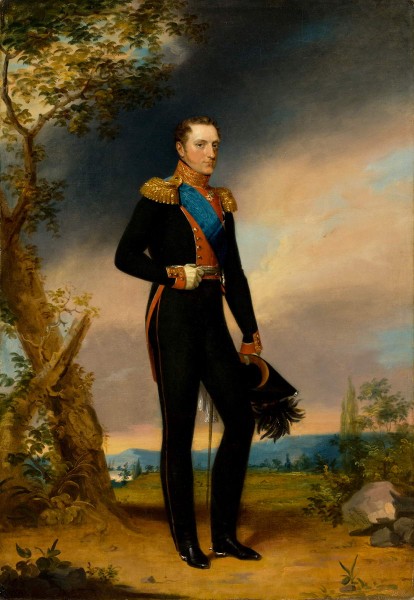Artist – Petrov -Vodkin

For Petrov-Vodkin, as for many of his contemporaries, the revolutionary events of 1905 and the First World War became a symbol of universal madness and the beginning of the collapse of the Russian world. But it is in such tragic breaks of history that every artist seeks emotional support in the wealth of centuries -old national culture. In 1913-1915, Petrov-Vodkin worked on murals in the cathedrals of Kronstadt and Sumy. It is possible that this influenced the appearance of such an unusual easel work as „The Mother of God is the emotion of evil hearts “(the author’s name; in Orthodox iconography – „Softening of evil hearts "). The picture, painted in 1915, in the midst of the First World War, acquires special significance as the artist’s spiritual response to tragic events.
With his hands, the Virgin in the picture appears in eternal prayer. The fiery scarlet color of her clothes pulsates as a beating of the heart, sounds like an alarm announcing the trouble that has come down to the ground. In the blue-blue essay of the bright halo of the Virgin, visions of her earthly life arise. On the left, as a reminder of her great purpose – she herself with the baby Christ in her arms, on the other side – the Savior crucified on the cross, as the echo of her great suffering – the mother of the Son of God. The Mother of God is depicted by a faint, close-up, her face is gentle and clear, there is some special simplicity and openness in it. The image created by the artist, dignified and lyrical at the same time. This is the image of the consolation by the console, "the warm intercessor of the world of the cold". A small canvas is perceived as a large, monumental work. The trembling and exalted image of the Virgin, created by the master, in the depth of influence-is one of the most powerful in the work of Petrov-Vodkin.
+ About the restoration of the work
– Hide the text about restoration
The canvas was received by the Museum from the Okunev Assembly in 1985. The picture was without a subframe (the canvas is nailed with nails to a wooden tablet). The canvas was very warmed up, the hard breaks of the colorful layer and soil gaped everywhere. Unprofessional tinting were noticeable – they almost everywhere entered the author’s painting and were very different from it in color and tone.
At the Restoration Council, it was decided to convey the picture to Marina Kiseleva, an artist-restorer of painting by the Russian Museum. When studying a colorful layer in the light of ultraviolet radiation, she accurately determined the boundaries of all records. It was confirmed that they were later – applied along a layer of slightly yellowed varnish, and some even in the loss of a colorful layer.
Restoration took 8 months. First of all, the canvas was neatly removed from the tablet. The colorful layer is several times strengthened with adhesive solution on the front side and is repressed. A new subframe was ordered to which, later, the picture was stretched. Then, the front surface was washed from contaminants, the yellowed varnish was thickened, and the notes were softened and neatly removed with a scalpel using a binocular microscope. The next step was to bring the new soil to the places of loss and tinting these sites. Restoration Council noted the high quality of the work performed.
The state of safety before restoration:
Before entering the restoration workshop, the picture was stored without a subframe, fixed by nails on a wooden tablet. Hard horizontal raised soil breaks covered the entire surface. The canvas itself was greatly crumpled and clearly gave a shrinkage due to the lack of tension on the subframe. In some places on the face, background and along the edges there were old gross restoration records in the losses and scuffs of author’s painting.
Complex of the events:
During the restoration process, the picture was stretched on a working subframe to stretch the canvas to the original size. To soften the colorful layers, soil and canvas, the picture on the back was processed by a special solution – the appendix. On the front side, the colorful layer according to the traditional method was strengthened by sturgeon glue, heated and rebuilt. As a result of system conservation measures, raised fractures were laid, the surface was leveled. As time has shown, the state of the picturesque layers stabilized and there are no tendencies to activate the breaks. Further, on the back of the copyright canvas, restoration edges were brought down, and the picture was stretched on a new manufactured subframe.
The picturesque restoration was to remove pollution and gross restoration records, tinting loss and scuffs. At the end of the work, the picture was covered with a thin film of light restoration varnish. Keeping a story. Restoration workshop of the Russian Museum – 100 years. SPb, 2022. With. 140-141.
